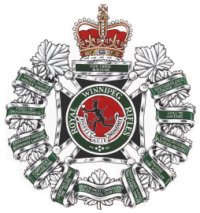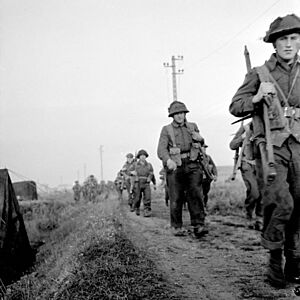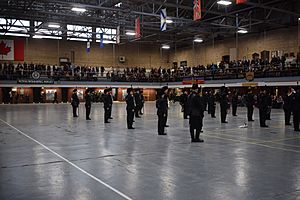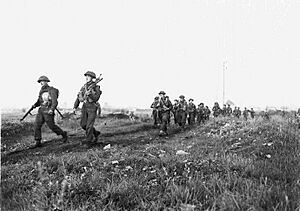Royal Winnipeg Rifles facts for kids
Quick facts for kids Royal Winnipeg Rifles |
|
|---|---|

Cap badge of the Royal Winnipeg Rifles
|
|
| Active | 1883–present |
| Country | Canada |
| Branch | Canadian Army |
| Type | Rifles |
| Part of | 38 Canadian Brigade Group |
| Garrison/HQ | Minto Armoury, Winnipeg, Manitoba |
| Nickname(s) | Little Black Devils |
| Motto(s) | Hosti acie nominati |
| March | "Old Solomon Levi" |
| Commanders | |
| Colonel-in-Chief | The Prince of Wales |
| Abbreviation | R Wpg Rif |
The Royal Winnipeg Rifles (R Wpg Rif) are a special group of soldiers in the Canadian Army. They are a "Primary Reserve" unit, which means their members train part-time. They are also known as the "Little Black Devils". Their home base is at Minto Armoury in Winnipeg, Manitoba. The Royal Winnipeg Rifles are part of the 3rd Canadian Division's 38 Canadian Brigade Group.
Contents
The Story of the Royal Winnipeg Rifles
The Royal Winnipeg Rifles have a long and interesting history. They started as the 90th Winnipeg Battalion of Rifles on November 9, 1883. Lieutenant Colonel William Nassau Kennedy was their first leader.
Early Days: Fighting in Canada
Just two years after they began, the 90th battalion helped in the North-West Rebellion in 1885. They fought bravely at places like Fish Creek and Batoche. Their Latin motto, hosti acie nominati, means “named by the enemy in battle.”
After the Battle of Fish Creek, a captured Métis person asked, "The red coats we know, but who are those little black devils?" Other soldiers wore red uniforms, but the Winnipeg soldiers wore dark green, which looked almost black. From that day on, they were called the "Little Black Devils."
Some of their members also served in the Second Boer War in South Africa. Because of their service, they earned a special honour called the "South Africa 1899–1900 battle honour."
World War I: The Great War
During World War I, also known as the Great War, the regiment formed several groups of soldiers. The most famous was the 8th Battalion (90th Winnipeg Rifles), CEF. This group fought in some of the toughest battles of the war. They showed great courage at places like Ypres, the Somme, Vimy, and Passchendaele.
Three soldiers from the 8th battalion received the Victoria Cross. This is Canada's highest award for bravery in battle.
In 1935, the unit was given the special name 'Royal' by King George V. This was to honour their excellent service. That's when they became known as The Royal Winnipeg Rifles.
World War II: D-Day and Beyond
In World War II, the Royal Winnipeg Rifles played a very important role. They arrived in England in September 1940. On D-Day, June 6, 1944, they were among the first Allied soldiers to land on the beaches of Normandy, France. This was a huge moment in the war.
The Royal Winnipeg Rifles fought hard throughout the Normandy campaign. They were part of famous battles like Caen and the Falaise Gap. They also helped free several port cities. Later, they fought to clear the Scheldt Estuary, which helped open the Antwerp harbour for supplies. After helping to free the Netherlands, they were ready to attack a town in northern Germany when the war ended.
Three different battalions (groups of soldiers) from the regiment served during World War II. The 1st Battalion fought in Europe. The 2nd Battalion stayed in Winnipeg as a reserve unit. A 3rd Battalion served in Germany after the war.
Helping at Home and Abroad
In 1950, the regiment helped people during the big Winnipeg flood. This was called Operation Red Ramp. From 1951 to 1953, they sent soldiers to Germany for NATO duty. Members also served in the Korean War.
In 1955, another military unit, the Winnipeg Light Infantry, joined with The Royal Winnipeg Rifles. This brought together the histories of both groups.
On June 6, 1964, a monument was built on the beaches at Courseulles-sur-Mer to remember their D-Day landing. In 1978, Prince Charles, who is now King Charles III, became the Colonel-in-Chief of the regiment.
In 1983, The Royal Winnipeg Rifles celebrated 100 years of serving Canada. They even had an official postage stamp made! More recently, soldiers from the regiment have served overseas in places like the Balkans and Afghanistan.
In 2009, the Royal Winnipeg Rifles and another unit, the Queen's Own Cameron Highlanders of Canada, worked together as the Winnipeg Infantry Tactical Group (WITG). They kept most of their traditions but shared a leader. In 2018, they separated again. Now, the Royal Winnipeg Rifles' main job is to maintain the Arctic Response Company Group, which helps in Canada's northern regions.
The Royal Winnipeg Rifles also "perpetuate" many older units. This means they carry on the history and traditions of these groups, making sure their stories are not forgotten.
How the Regiment is Organized
The Royal Winnipeg Rifles has a clear structure with different leaders and groups:
- Leaders:
- Colonel-in-Chief: Charles, Prince of Wales (now King Charles III)
- Honourary Colonel: Emőke Szathmáry
- Honourary Lieutenant-Colonol: Abdo El Tassi
- Commanding Officer: Lieutenant-Colonel Dennis G. Desrochers
- Regimental Sergeant Major: Chief Warrant Officer Joel Alo
- Band Sergeant Major: Master Warrant Officer Emily Kenny
- Groups within the Battalion:
- Alpha Company
- Regimental Band
- Ceremonial Detachment (The Skirmishers and The Pioneers)
- Sub-Units
The Regimental Band is very old, starting in 1883. It's the oldest concert band in Winnipeg! In 1885, band members even went with the regiment to the Northwest Rebellion. Today, the band plays many types of music and helps keep the spirit of the regiment strong.
Special Traditions
The Royal Winnipeg Rifles follow special traditions, like other rifle regiments. For example, they don't have large "regimental colours" (special flags). Instead, their battle honours (awards for bravery in battle) are shown on their cap badge and drums.
They march at a fast pace of 140 steps per minute, faster than the usual army pace. Their rifles are often carried "at the trail," which means held low. The regimental badge shows a devil with a trident, running, like a rifleman in battle. Also, their buttons and badges are darkened, not shiny, for better camouflage.
A trained private soldier in the Royal Winnipeg Rifles is called a "Rifleman."
The regiment has special groups for ceremonies:
- Pioneers: These soldiers wear leather aprons and carry old tools like axes and halberds (a type of spear). They escort the colours (flags) during parades.
- Skirmishers: These soldiers wear the traditional uniform of a 90th Battalion rifleman from 1885. They often appear at ceremonies like Remembrance Day.
The official march music for the Royal Winnipeg Rifles is "Pork, Beans and Hard Tack (Old Solomon Levi)". Their fast march music is "The Keel Row."
Special Recognition
On November 10, 1983, Canada Post released a special stamp to honour The Royal Winnipeg Rifles. It was part of a series celebrating Canadian military regiments.
Battle Honours: Awards for Bravery
Battle honours are special awards given to military units for their bravery and success in battles and campaigns. The Royal Winnipeg Rifles have earned many of these honours throughout their history. The ones in bold are proudly shown on their cap badge.
- North West Rebellion
- South African War
- First World War
- Ypres, 1915, '17
- Gravenstafel
- St. Julien
- Festubert, 1915
- Mount Sorrel
- Somme, 1916, '18
- Flers–Courcelette
- Thiepval
- Ancre Heights
- Ancre, 1916
- Arras, 1917, '18
- Vimy, 1917
- Arleux
- Hill 70
- Passchendaele
- Amiens
- Scarpe, 1917, '18
- Drocourt–Quéant
- Hindenburg Line
- Canal du Nord
- Cambrai, 1918
- Valenciennes
- France and Flanders, 1915–18
- Second World War
- Normandy Landing
- Putot-en-Bessin
- Caen
- Carpiquet
- The Orne
- Bourguébus Ridge
- Falaise
- The Laison
- The Seine, 1944
- Calais, 1944
- The Scheldt
- Leopold Canal
- Breskens Pocket
- The Rhineland
- Waal Flats
- Moyland Wood
- The Rhine
- Emmerich–Hoch Elten
- Deventer
- North-West Europe, 1944–1945
- War in Afghanistan
- Afghanistan
Alliances
The Royal Winnipeg Rifles have a special connection with:
 United Kingdom — The Rifles (a British army unit)
United Kingdom — The Rifles (a British army unit)
Royal Canadian Army Cadets
The Royal Winnipeg Rifles also have a youth group called the Royal Winnipeg Rifles Cadet Corps. It started in 1947 and is based at Minto Armoury in Winnipeg. Cadets learn about the army, leadership, and citizenship.
Victoria Cross Heroes
These brave soldiers from the Royal Winnipeg Rifles received the Victoria Cross, Canada's highest award for military bravery:
- Alexander Picton Brereton
- Frederick George Coppins
- Frederick William Hall
The Royal Winnipeg Rifles Museum and Archives
| Location | Minto Armoury, 969 St. Matthews Avenue, Winnipeg, Manitoba, Canada |
|---|---|
| Type | Military Museum |
The museum helps keep the history of The Royal Winnipeg Rifles alive. It collects and displays old items and records from 1870 to today. It's a place where people can learn about the regiment's past and feel proud of their achievements. The museum also keeps track of all memorials and monuments related to the regiment.
More Information
You can learn more about the Royal Winnipeg Rifles from these books:
- Named by the Enemy: A History of the Royal Winnipeg Rifles by Brian A. Reid (2010)
- Little Black Devils: A History of the Royal Winnipeg Rifles by Bruce; Wells, Eric Tascona (1983)
Images for kids







